Like many people, I usually put tape covers over my CGM sensors. Initially it was to make sure they stayed in place for their full life, even when I was spending lots of time in tropical waters. With the Dexcom sensors I find it has other benefits too:
- Helping keep the sensor more stable. Less movement means less degradation of the filament under the skin.
- Helping keep water from the transmitter/sensor interface. Usually this is protected by dielectric gel in the sensor housing, but this can wear away over time.
- Helping the sensor remove cleanly at the end, without “junk” stuck to my skin.
These have helped me keep sensors running for a long time. Before we had the NDSS CGM Subsidy there was a lot of incentive to make these expensive sensors last as long as possible. My record for a G5 sensor was >50 days (although my average was much smaller). My average sensor life with G6 sensors has turned out to be around 16 days.
I’ve used many things over the years, including RockTape (both from RockaDex and RockTape I’ve cut to shape myself) but eventually settled on clear medical tapes. Earlier this year I found a new option though, which is what this article is about.
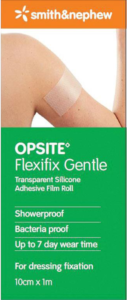 Opsite Flexifix Gentle
Opsite Flexifix Gentle
Note that this is different from the regular Opsite Flexifix.
This is a silicone-based dressing. Not only is it unlikely to cause skin irritation (which admittedly has not been a problem for me with any of the dressings anyway) but it also can be removed easily when needed.
It’s not a coincidence that devices like the the Eversense transmitter (which is supposed to be removed/re-attached daily) and the Upright Go posture trainer also use silicone adhesives.
 I buy the 10cm-wide roll, and cut a square from the end, then roughly round the corners off with scissors (makes it less likely to peel/lift). I keep a stack of these in a ziplock bag with my CGM sensors.
I buy the 10cm-wide roll, and cut a square from the end, then roughly round the corners off with scissors (makes it less likely to peel/lift). I keep a stack of these in a ziplock bag with my CGM sensors.
Installing
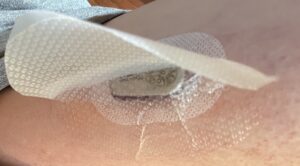 This sensor was being installed on the back of my upper arm.
This sensor was being installed on the back of my upper arm.
As you can see earlier. the backing is in two halves. After the sensor’s in and warming up, I remove half of the backing and stick it to transmitter then push out to one side.
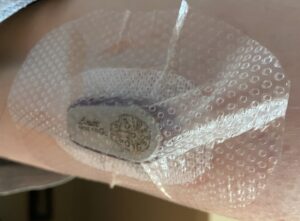 I then remove the other half of the backing, and seal the dressing down to the other side. I actually stretch the skin away from the sensor slightly while doing this, so when it relaxes the tape won’t be pulling across the skin surface.
I then remove the other half of the backing, and seal the dressing down to the other side. I actually stretch the skin away from the sensor slightly while doing this, so when it relaxes the tape won’t be pulling across the skin surface.
You can see I’ve deliberately left the ends un-stuck.
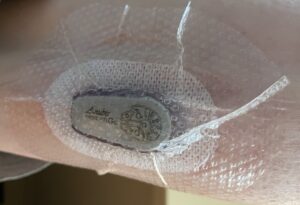 I then pinch in at each end of the transmitter (to minimise the bubble of air that might be trapped inside) and push out to the edges. This example wasn’t perfect, but you get the idea.
I then pinch in at each end of the transmitter (to minimise the bubble of air that might be trapped inside) and push out to the edges. This example wasn’t perfect, but you get the idea.
The extra dressing ends up in folds as you can see, but they are unobtrusive.
Here you can see this same sensor after 7 days of wear:
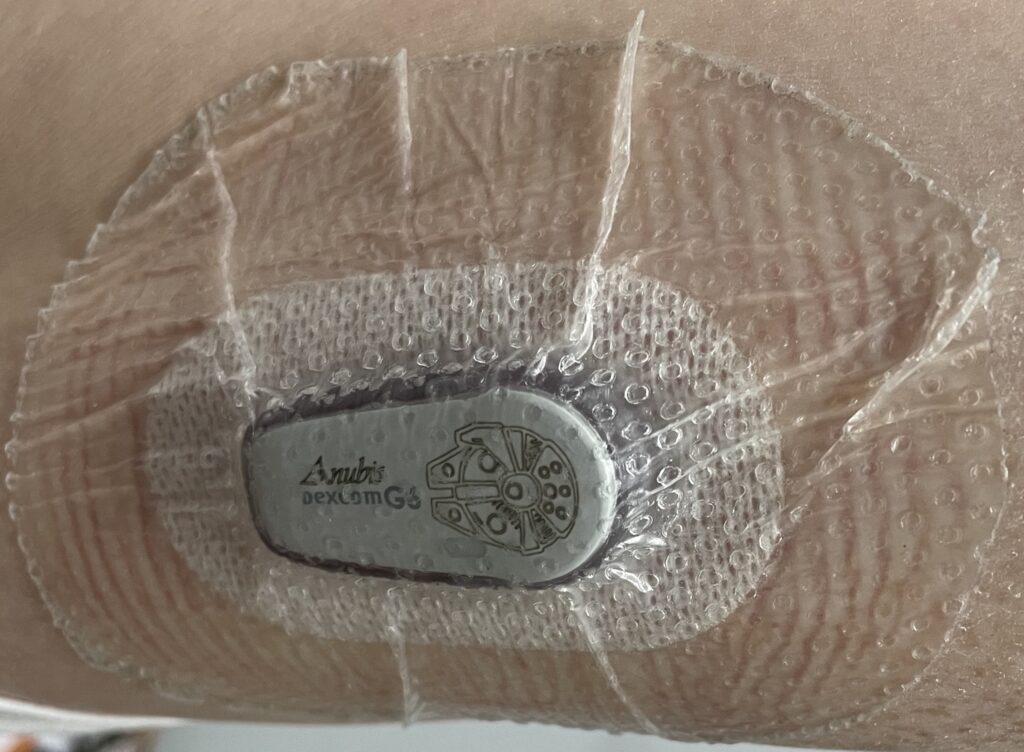
Covering the transmitter
Obviously I’ve covered the entire thing including the transmitter. Admittedly Dexcom advise to not do this.
I have done this for long with with various dressings, and my transmitters are able to communicate unimpeded. They’re medical dressings, and I think of them as designed to maintain the moisture levels underneath as appropriate for healing skin. I’ve never had irritation occur under the tape.
The only times I’ve had water trapped inside was when it was worn out and no longer sealed appropriately at the edges (or there was a hole in the tape). Maybe twice in 4+ years.
Removing
The dressing is labelled as being appropriate for up to 7 days use. But I have worn it longer.
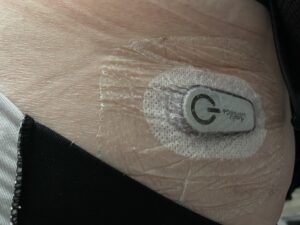
This sensor had been in place for 13 days when I decided to remove it. As you can see, the dressing is still stuck fairly securely.
It was on my upper bum (that’s my underwear rolled down) and it’s a gymnastic exercise to photograph back there, so please excuse the poor lighting!
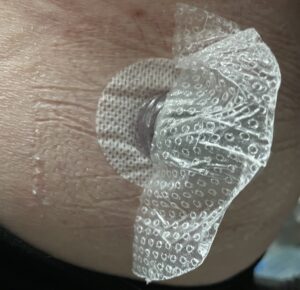 I worked away at an edge with my fingernail and then started peeling it back.
I worked away at an edge with my fingernail and then started peeling it back.
As you can see, the sensor underneath gets left behind!
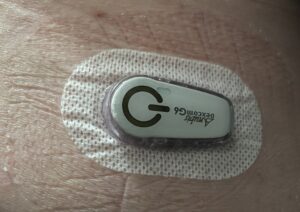 Once it all comes off, the sensor is physically almost pristine.
Once it all comes off, the sensor is physically almost pristine.
I apply the dressing almost as soon as the sensor is inserted. So the white tape has no chance to gather grime/dust. Consequently there’s no ring of adhesive bonded with grime. That can leave sticky gunk left behind on both the skin and the transmitter.
When the sensor itself is removed, my skin is clean!
Caveat
I have not yet used this with swimming. If it turns out to be not robust against that I will probably fall back to regular Opsite Flexifix for those periods. However that doesn’t remove as neatly.
That’s much thinner stuff, so when using that when the edges eventually start to lift I trim them off with nail scissors to avoid them catching on things, and if the dressing shrinks enough I simply apply another layer over the top! But when removing the regular Opsite Flexifix it maintains a good hold on the sensor. If I need to remove the transmitter for some reason I would end up just cutting the dressing around the transmitter itself, leaving the Opsite on the outer area.
I’ve decided I’m mostly going to use the silicone-based dressing from here on though.

Thanks! We use these stickers since nov-2021 which are working great for my girlfriend https://www.amazon.nl/dp/B091H18ZJY/ . No more cutting and adjustments. Most of the time (not always) sticker stays attached till sensor change, in our case also around day 15-16. All the best, Peter
Thanks for alerting about another dressing option I wasn’t aware of David – as usual really helpful.
How do you get the sensor to last that long? I thought they only lasted 10 days
You can see I’m using an Anubis transmitter. That’s been set to not terminate the session after 10 days: 60 days is the upper limit.
These are recycled Dexcom G6 transmitters, not official product (in fact they say “ANIMAL USE ONLY” on the underside). They’re an Australian creation, but are now available in Europe and the US via some of the existing re-batterying people.
If you were using an original Dexcom unit I imagine you could remove this tape after 10 days, pop the transmitter off for 15 minutes, put it back in and restart it with the original sensor code, tape it over again, then once it had warmed up give it one good calibration which should bring it down to target.
I have never used anything other than Dexcom’s provided-on-request tapes that have the transmitter cut-out, but now you have me thinking that it might be valuable to use something like the tape you mentioned, even just for keeping sensors secure over long wear times (when using Anubis transmitters in particular). Thanks for the food-for-thought.
The pictures are helpful; and particularly illustrate that there is little need to worry about folds in the tape. I would have expected them to compromise the seal, but fortunately that does not seem to be your experience.
Also, I can’t imagine I am the only one that would be interested in an update regarding how they hold up to prolonged water (tropical or otherwise) exposure.
We’re only just past the depths of winter at the moment. I’m using them on every sensor now, so we’ll see how they go as we get into summer. It’s not particularly tempting to even go swimming at the moment. 🙂
So far they’ve withstood daily showers and occasional sweaty exercise.
Reports from others indicate that having a nice wide border helps avoid water ingress along those folds.
Do you think the Opsite Flexifix would work in securing Omnipod’s tubeless insulin pumps?
Falling Omnipods are an issue for a 4 year old boy, since they sometimes get caught in the playground.
I haven’t felt the need whenever I’ve used pods, but I’m not a 4yo!
If I was to experiment with that, the flexibility of removing/rearranging the silicone Flexifix Gentle version might be an advantage.
Hi all
I’ve tried to place an order for the Opsite Flexifix Gentle but I’ve been told that the product has been discontinued by the suppliers.
Are there any other alternatives that one might suggest?
Thanks!
Eeek. Thanks for the heads-up.
No, Smith & Nephew (Australia) tell me it’s not discontinued, and they have plenty in stock.
Maybe ask your pharmacy to just look a bit harder?
You’re right. The suppliers to that pharmacy themselves are discontinuing it.
Did try to order it from the link Smith & Nephew had on their site. Not a single pharmacy near where I live that that was advertised on their site has got it.
Chemist Warehouse here I come then.